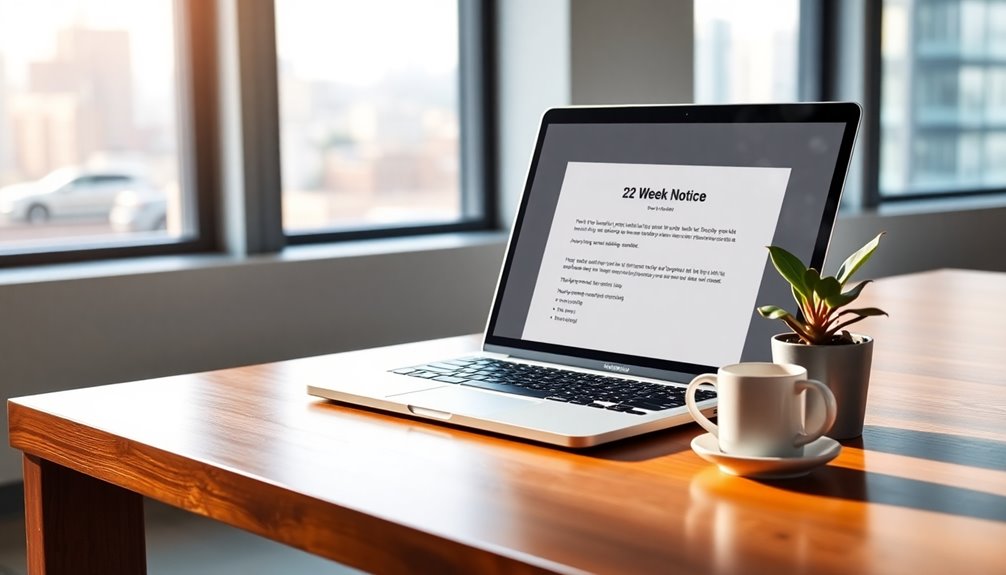To write a follow-up email that boosts your chances of getting hired, wait about 1-2 weeks after your application. Start with a personalized subject line that includes your name and the job title. In the body, express your genuine interest in the role while highlighting your unique qualifications. Keep your email concise and professional, using short sentences and bullet points for readability. Thank the hiring manager for their time and politely inquire about the application status. This approach shows respect and enthusiasm, setting you apart. Stick around to discover more tips for crafting impactful follow-up emails!
Key Takeaways
- Wait 1-2 weeks after applying to follow up, or 5-7 days for fast-moving companies, to avoid appearing pushy.
- Use a clear subject line that includes the job title, your name, and the company for easy identification.
- Personalize the email by including the recipient's name, referencing the job position, and expressing genuine interest in the company's culture.
- Highlight unique qualifications and relevant experiences concisely, ensuring the message is polished and free of errors.
- Maintain professionalism by keeping the tone polite, expressing gratitude, and respecting the hiring manager's time with concise communication.
Introduction

When you've applied for a job, it's natural to feel eager for a response. You might wonder when to follow up and how to craft the perfect email to grab the recruiter's attention.
Timing is crucial; waiting at least two weeks after your initial application shows patience and professionalism. Before hitting send, check the job posting for any specific timelines or instructions regarding follow-up communications. Following up too soon can make you seem pushy, so give it some time. Mindful follow-up timing can create a positive impression and shows respect for the hiring manager's schedule.
When you do decide to follow up, make sure your email stands out. Start with a clear subject line that includes your name, the role title, and the company name. For example, "Following Up On Application for [Position] at [Company Name] – [Your Name]" is effective and easy for recruiters to locate.
Keep the email concise and professional. Thank the hiring manager for considering your application, mention the position, and highlight your relevant skills.
Inquire about the decision timeline or next steps, and offer to provide any additional information if necessary. Always proofread your email to ensure it's polished and free of errors.
Demonstrates Your Continued Interest

Following up on your job application is a great way to demonstrate your continued interest in the position. Start by reiterating the specific job title and company, along with the date you submitted your application.
Express your enthusiasm for the opportunity and explain why you believe this role is a perfect fit for your skills and experience. The process of effective communication can also be crucial in conveying your intentions clearly.
Highlight your top qualifications that align with the job description, focusing on key experiences relevant to the position. Avoid repeating what's already in your resume; instead, emphasize unique strengths and notable achievements that set you apart from other candidates. Remember that following up reinforces your interest in the position and demonstrates professionalism and initiative.
Always show gratitude and respect by thanking the hiring manager for their time and consideration. Acknowledge their busy schedule and appreciate the chance to apply.
Maintain a courteous and professional tone throughout your email.
Personalized Subject Line

A personalized subject line can significantly increase the likelihood that your follow-up email will be opened and read. By including the recipient's name, you boost the chances of your email being noticed by 22.2%. This simple touch makes the recipient feel more connected to you and the brand, showing that you pay attention to details.
To craft an effective personalized subject line, consider including the recipient's name, like "Following up on my application for [Job Title], [Name]." You can also reference the job title or company to provide context, such as "Checking in on my job application for [Job Title] at [Company Name]."
Mentioning specific projects or previous conversations adds a personal touch, like "Following up on our discussion about [specific project]."
Additionally, using a compelling subject line can drive engagement and enhance visibility, making it more likely that your email will be prioritized by the recipient. Keep your subject lines relevant and direct, avoiding unnecessary fluff. Aim for clarity and conciseness, and try to keep it under 50 characters to ensure it displays well on mobile devices.
Starting with keywords can help maximize visibility, ensuring your email stands out in a crowded inbox. Remember, a well-crafted subject line sets the tone for the entire email.
Step-by-Step Guide to Writing Follow-Up Emails

Crafting a well-structured follow-up email is key to maintaining a positive impression after your application. Start by waiting 1-2 weeks after submitting your application to send your email. If the company provided a specific timeframe, respect it and follow up only after that period has passed.
Keep your email concise and clear. Express your enthusiasm for the position and reiterate your interest. Highlight relevant skills and qualifications that align with the job description to remind them why you're a great fit. Finding the right contact can also help ensure your email reaches the appropriate person.
Politely ask about the status of your application and inquire about the next steps in the hiring process. Maintain a professional tone throughout your email. Show gratitude for the opportunity to apply and thank the hiring manager for their time.
Make sure your email is free of grammatical errors and typos, which can undermine your professionalism. At the end, include your full name, phone number, and LinkedIn profile, if applicable, for easy contact.
Be ready to follow up again if you don't receive a response, but limit your follow-ups to two to avoid coming across as overly aggressive.
Dos and Don'ts for Follow-Ups

Navigating the follow-up process after submitting your application requires a strategic approach, and knowing the dos and don'ts can make a significant difference.
First, always be polite and professional. Use clear, professional language, maintain a respectful tone, and express gratitude for the hiring manager's time. Reiterate your interest in the role and mention specific aspects of the job that appeal to you. Additionally, consider using email as a preferred method for follow-ups, as it allows for thoughtful responses at the recipient's convenience.
Be patient and persistent. Wait one to two weeks before following up, and if you don't hear back, send a gentle reminder. However, avoid being overly pushy; respect the hiring manager's timeline.
On the flip side, don't bombard them with multiple reminders or make ultimatums. Respect their communication preferences—if the job posting advises against contacting them, don't reach out.
Keep your messages concise and avoid redundancy; don't repeat information from your application. Each follow-up should add value or new insights.
Follow-Up Email Samples

When you're ready to send a follow-up email, having a solid template can streamline the process and ensure you cover all essential points.
Start with a clear subject line, like "Following Up On Application for [Position] at [Company Name] – [Your Name]." This grabs attention immediately.
In your brief introduction, mention the job title, the company, and the date you applied. Keep it concise.
Next, reiterate your interest in the position and highlight relevant skills and experiences that align with the job's needs. This connection shows you're a great fit. Additionally, it's important to wait 5-7 business days after applying to allow hiring managers adequate time to review applications before following up.
Don't forget to inquire about the status of your application, asking about the decision timeline or next steps.
Offer to provide additional information, and express your eagerness for an interview. Maintain a professional tone throughout, showing respect for the hiring process and the company's culture.
Pro Tips for Writing Effective Emails

Sending a follow-up email can feel daunting, but it doesn't have to be. Start by timing your email right; wait 1-2 weeks after submitting your application, or 5-7 business days if the company moves quickly. Avoid appearing impatient by not following up too soon. If you don't hear back, give it another week or two before sending a final follow-up.
Your subject line should be clear and concise, including the job title and your name. Begin your email with the purpose upfront, keeping it brief and to the point. Utilize short sentences and bullet points for better readability.
Reiterate your interest in the position and express enthusiasm for joining the team. Highlight your top qualifications without repeating your resume. Personalize the content by researching the company and aligning your experience with their needs. Always show gratitude for the hiring manager's time. Following up on a job application reinforces your interest in the position and demonstrates professionalism.
Maintain professionalism throughout your email. Use a formal closing like "Sincerely" or "Best Regards," followed by your full name and contact information.
Final Thoughts

A follow-up email can be a crucial step in your job application journey. It's your chance to reinforce your interest in the position and remind the hiring manager of your qualifications.
Remember to keep your tone professional and courteous; you want to show respect for the recipient's time and workload. Mistakes can undermine your professionalism, so ensure your email is polished and error-free.
Timing is key; wait at least two weeks after applying to send your follow-up. Following up too soon can come across as pushy, while a second follow-up should only happen if you've checked that the job ad is still active and a week or two has passed without a response. Timing is crucial to create an opportunity for a positive impression.
Personalization matters. Reference the specific job position, company, and application date to make your email stand out.
Mention skills that align with the job description and express genuine interest in what the company offers.
Frequently Asked Questions
How Long Should I Wait Before Sending a Follow-Up Email?
You should wait about 5-7 business days after submitting your application before sending a follow-up email.
If you don't hear back, consider waiting one to two weeks for a more respectful approach.
Check the job posting for any specified time frames, as some companies outline their hiring timelines.
Patience is key; remember that the recruitment process can vary, and following up too soon might come off as pushy.
Can I Follow up if I Haven't Heard Back at All?
Yes, you can absolutely follow up if you haven't heard back. It's perfectly acceptable to reach out after one to two weeks, showing your continued interest in the position.
Just ensure you maintain a professional tone and keep your message concise.
Politely inquire about the status of your application, and express gratitude for their time.
This approach demonstrates your enthusiasm without being overly pushy, making a positive impression.
Is It Appropriate to Call Instead of Emailing?
It's generally best to stick to emailing when following up on job applications.
Calling can come off as intrusive, especially if the company hasn't indicated a preference for it. If a week or two has passed and you haven't heard back, check the job posting for any specific instructions.
If calling seems appropriate, keep it brief and professional, but be prepared for the possibility that the hiring manager may not appreciate the interruption.
What if I Have Multiple Applications With the Same Company?
If you've got multiple applications with the same company, it's crucial to stay organized.
Use a job tracker to manage each application's details and status.
When following up, personalize each email, addressing the specific hiring manager and mentioning the job title.
Tailor your content to highlight different skills for each role.
Keep a professional tone, and avoid mixing up timelines or information to ensure clarity and avoid confusion.
How Can I Handle Rejection in a Follow-Up Email?
When handling rejection in a follow-up email, start by acknowledging the response graciously. Thank the hiring manager for their time and any feedback they offered. When handling rejection in a follow-up email, start by acknowledging the response graciously. Thank the hiring manager for their time and any feedback they offered. Express your gratitude for the opportunity to interview and reiterate your appreciation for their consideration. Writing a respectful rejection email, as they did, demonstrates professionalism and leaves room for a positive impression. You can also express interest in staying in touch for future opportunities or ask for advice to continue growing in your career.
Keep your tone professional, even if you're disappointed. Wish the company well and express appreciation for the opportunity.
Use any feedback to improve your future applications, and remember to stay positive.
Keep applying and exploring other opportunities; rejection is just a stepping stone in your job search journey.









